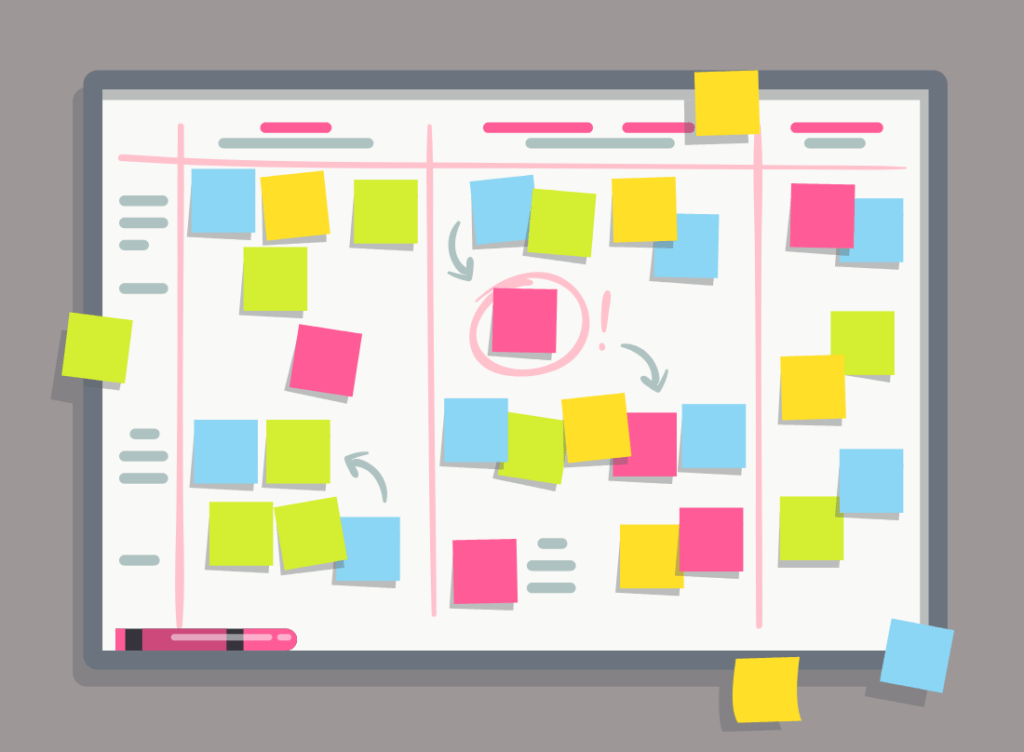
Do you often spend countless hours trying to keep track of various tasks that need completing? Visual management boards may be the perfect solution.
A visual management board is an interactive way to make processes more manageable. It allows team members to monitor progress and easily take ownership of their work.
In this blog post, we’ll discuss why these boards are essential in managing workflow at any business or organization. It also provides tips on how to set up an effective board.
What Are The Reason To Use Visual Management?
Visual management has become essential for businesses of all sizes and industries. This approach involves using visual aids such as charts, graphs, and diagrams to convey critical information that would otherwise be lost or misinterpreted in a sea of text.
Statistically, it has been shown that humans are more responsive to visual data and can process it up to 60,000 times faster than text alone. Therefore, visual management effectively improves communication and makes complex information more accessible to everyone.
By displaying important information like goals, milestones, and metrics clearly and concisely, a visual management board can help teams stay focused and motivated. Besides, it can streamline processes, reduce errors, and enable teams to make more informed decisions.
By utilizing visual management, businesses can improve their productivity and enhance customer satisfaction.
What Is A Visual Management Board?

A visual management board is a display board that represents information clearly, concisely, and visually appealingly. They aid in the dissemination of accurate and relevant information. It allows everyone in the organization to monitor progress and identify problems in real-time.
There are various types of visual management boards, including shadow boards, kanban boards, performance boards, quality control boards, and safety boards. lean visual management board examples:
- A Kanban board manages workflow and inventory levels in a manufacturing process.
- In contrast, a performance board tracks metrics and KPIs related to sales or marketing.
Whether tracking personal productivity goals, breaking down complex projects into sections, or assigning each task to a specific member, a well-organized visual management board will empower everyone involved.
Key Benefits Of A Visual Management Board?
A visual management board can help you manage, measure and optimize the flow of work in your organization very efficiently. Take a look at the benefits in detail:
1. Quick Problem Solving
A visual management board can help identify potential problems before they occur, allowing the team to act quickly and effectively.
The board can be designed to include information such as customer complaints, production errors, and supply chain issues. It ensures that everyone is on the same page.
It makes it easier to solve the problem, as they have access to all the relevant information, required subtasks, and timelines.
2. Time-Saving
Visual management boards are an excellent way to reduce time wasted during meetings. With easily accessible information on the board, team members can quickly grasp the topic at hand.
According to research, companies that use visual management tools save an average of 30 minutes per meeting, translating to thousands of dollars in annual savings.
When tasks are visible and are organized by priority, team members do not have to spend time tracking the status of tasks.
3. Better Accountability
Lean visual management boards can make the team members accountable for their role in the process and keep everyone in the loop on what’s happening. Sharing data, such as productivity statistics, goal achievement, and other relevant metrics, foster transparency and a sense of ownership.
Besides, it allows the team members to track their progress and take action where they fall short to improve performance continually.
Moreover, this transparent view of work creates an environment of more straightforward communication, and team members are more likely to take ownership of their work.
4. Improved Work Efficiency
Such boards can keep the team aligned with their objectives, deadlines, and targets, improving communication channels. It reduces the need for redundant communication, provides project visibility, increases focus, and reduces distractions.
Further, incorporating data, such as industry benchmarks and customer feedback, can help teams understand how their work impacts their customers. It enables them to fine-tune their processes based on that information.
5. Safer Workflows
Visual management boards also promote safety by enhancing communication and awareness of hazards. Using visuals to create a safety checklist or highlight PPE requirements reminds team members of the potential risks.
Furthermore, it can illustrate relevant safety information concerning the equipment and maintenance protocols for that equipment.
6. Efficient Work Prioritization
Visual management boards can be used for prioritizing tasks, allowing teams to organize and prioritize their work through daily, weekly, or monthly schedules.
This way, the team knows what tasks need to be completed and when they need to be finished, ensuring the right resources are available to achieve them.
7. Inventory Storage That Matches Production Demands
Visual management boards help establish standard work procedures from production to inventory storage. Production levels can only be met with the correct inventory levels.
Visual management boards display when inventory levels are low and can prompt reorder or production changes before the stock is depleted, leading to less inventory and increased asset efficiency.
8. Improved Team Performance
By using visuals, management boards enable teamwork on a whole new level. Team members can point out areas that require improvement, and as a group, they can brainstorm solutions.
Furthermore, displaying everyone’s respective tasks and goals encourages team members to work together to complete projects more efficiently. This, in turn, promotes better team performance, leading to increased productivity and more excellent work quality.
Tips On Setting Up An Effective Visual Management Board

Visual management board lean are powerful tools that help teams stay organized and focused on their goals. But, to get the most out of these boards, it’s essential to set them up effectively. Here are a few tips to help you do just that.
- Ensure your board is easily visible to everyone who needs to access it.
- Keep the design simple and easy to understand.
- Update the board regularly to keep information fresh and relevant.
- Use color coding and symbols to convey key information at a glance.
- Involve team members in the creation and upkeep of the board to increase ownership and engagement.
- Regularly review and evaluate the board’s effectiveness, making changes as needed to ensure it remains a valuable tool for your team.
Conclusion
A visual management board can help keep all the essential information you need in one central, easily-accessible location. Different types of boards are available to suit your personal or professional needs, so creating a visual board can be manageable.
The benefits of visual management speak for themselves, and it is no wonder why so many organizations have adopted this powerful tool. To achieve maximum efficiency and streamline the process at work, regularly review it, clearly label each section, add visuals that will grab workers’ attention, and update your content often for everything to stay organized and orderly.

